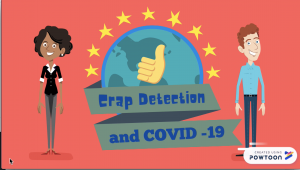These are unprecedented times. It is more important than ever to be skeptical about what we read on the internet. This week, I decided to try out Powtoon for part of my post.
If you are going to spread collective intelligence, you should not do so without verifying the truth, especially if it counters what is generally believed to be true. On the other hand, if something pops up on the internet that is generally believed to be untrue, people are more willing to jump in to disprove it. This disturbing video of a killer whale attacking a man instantly set off my crap detectors and I was quickly able to ascertain that it was an edited version of a seal attack. Why was I on it so quickly? I believe it was because I really like killer whales and I did not want it to be true.
There are plenty of claims out there that I have less interest in and seem relatively harmless so I discount them without looking further. Sometimes, the certainty is not worth my time, especially if I have no desire to pass it along, like it, share it, or talk about it. Other times, if I think I might want to pass it along, I will run the claim through Snopes first. The only time I really check into sources by examining authors, web site owners, or triangulating is if it is an opinion someone might argue against me about or something academic.
Should we teach Gillmor’s Five Principles of Media Consumption in school (Rheingold, 2012)? In Kindergarten, I would absolutely start teaching students about reliable and safe websites. I would definitely talk to them about the being careful of what someone might be trying to sell you. These points are prescribed for Kindergarten and other grades in BC’s Digital Literacy Framework. Also, in the framework, is the notion of handling requests for private information. The more that children understand how their input affects the internet’s output, the better.
When exploring the internet, everyone would benefit from being skeptical of what they find, thoughtful in their judgement, open minded to opposing views, aware of their filter bubble, persistent in asking questions, and educated in ways to verify information and sources.
References (Text and Video)
Ioannidis, J. P. A. (2020, March 17). In the coronavirus pandemic, we’re making decisions without reliable data. STAT. https://www.statnews.com/2020/03/17/a-fiasco-in-the-making-as-the-coronavirus-pandemic-takes-hold-we-are-making-decisions-without-reliable-data/
Maragakis. (2020). Coronavirus Disease 2019 vs. The Flu. John Hopkins Medicine. https://www.hopkinsmedicine.org/health/conditions-and-diseases/coronavirus/coronavirus-disease-2019-vs-the-flu
Rettner, R. (2020, March 17). How does the new coronavirus compare with the flu? Livescience.Com. https://www.livescience.com/new-coronavirus-compare-with-flu.html
Rheingold, H. (2012). Crap Detection 101: How to Find What You Need to Know, and How to Decide If It’s True. In Net Smart: How to Thrive Online (pp. 76–109). The MIT Press. https://hci.stanford.edu/courses/cs047n/readings/rheingold-net-smart.pdf

Hi Tracey,
I really enjoyed your video! What a great example of using a digital story to summarize your readings and connect to the real world. I always began teaching my own kids about apps and games early, even in Pre-K. While I would not use the words crap detection, I agree that the sooner we thinking critically about what information we are being inundated with, the better!
Thank you for sharing!
Verena 🙂
Thanks for the Snopes resource, and Gillmor’s Five Principles! Your video depicts an excellent and incredibly relevant example. Brilliant:)
I am always surprised by the skills most high school students have when working online. Most have learned what is safe and what is not and stay away from what is bad for them. On occasion, students do go to bad websites but that is usually to embarrass a friend or to be edgy. Of course that is still not appropriate so it gets shut down.